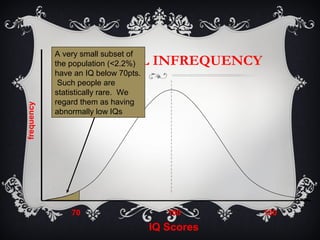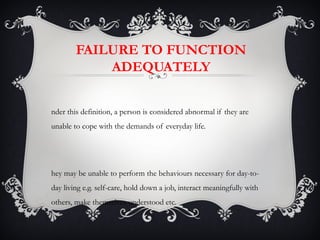Simple explanations of definitions
- 1. DEFINITIONS OF ABNORMALITY efining a person or behaviour as ŌĆśabnormalŌĆÖ implies something undesirable and requiring change herefore, we must be careful how we use the term sychologists need methods for distinguishing ŌĆśnormalŌĆÖ from ŌĆśabnormalŌĆÖ
- 2. DEFINITIONS OF ABNORMALITY ur definition of abnormality must be objective: ŌĆó It must not depend on anyoneŌĆÖs opinion or point of view ŌĆó It should produce the same results whoever applies it t must not be under- or over-inclusive ŌĆó It must not label as ŌĆśabnormalŌĆÖ or ŌĆśnormalŌĆÖ behaviours or traits that arenŌĆÖt
- 3. DEFINITIONS OF ABNORMALITY ou MUST have an understanding of the following three definitions for the exam: 1. Deviation from social norms 2. Failure to function adequately 3. Deviation from ideal mental health ou could have an understanding of the following definition for the exam: ŌĆó Statistical infrequency
- 4. STATISTICAL INFREQUENCY nder this definition, a personŌĆÖs trait, thinking or behaviour is classified as abnormal if it is rare or statistically unusual. ith this definition it is necessary to be clear about how rare a trait or behaviour needs to be before we class it as abnormal
- 5. STATISTICAL INFREQUENCY Average IQ in the population is 100pts. The further from 100 you look, the fewer people you find frequency 70 100 130 IQ Scores
- 6. A very small subset of STATISTICAL INFREQUENCY the population (<2.2%) have an IQ below 70pts. Such people are statistically rare. We regard them as having frequency abnormally low IQs 70 100 130 IQ Scores
- 7. DEVIATION FROM SOCIAL NORMS nder this definition, a personŌĆÖs thinking or behaviour is classified as abnormal if it violates the (unwritten) rules about what is expected or acceptable behaviour in a particular social group. heir behaviour may: ŌĆó Be incomprehensible to others ŌĆó Make others feel threatened or uncomfortable
- 8. DEVIATION FROM SOCIAL NORMS ith this definition, it is necessary to consider: ŌĆó The degree to which a norm is violated, the importance of that norm and the value attached by the social group to different sorts of violation. ŌĆó E.g. is the violation rude, eccentric, abnormal or criminal?
- 9. FAILURE TO FUNCTION ADEQUATELY nder this definition, a person is considered abnormal if they are unable to cope with the demands of everyday life. hey may be unable to perform the behaviours necessary for day-to- day living e.g. self-care, hold down a job, interact meaningfully with others, make themselves understood etc.
- 10. FAILURE TO FUNCTION ADEQUATELY osenhan & Seligman (1989) suggest the following characteristics: ŌĆó Suffering ŌĆó Maladaptiveness (danger to self) ŌĆó Vividness & unconventionality (stands out) ŌĆó Unpredictability & loss of control ŌĆó Irrationality/incomprehensibility ŌĆó Causes observer discomfort ŌĆó Violates moral/social standards
- 11. DEVIATION FROM IDEAL MENTAL HEALTH nder this definition, rather than defining what is abnormal, we define what is normal/ideal and anything that deviates from this is regarded as abnormal his requires us to decide on the characteristics we consider necessary to mental health
- 12. DEVIATION FROM IDEAL MENTAL HEALTH sychologists vary, but usual characteristics include: ŌĆó Positive view of the self ŌĆó Capability for growth and development ŌĆó Autonomy and independence ŌĆó Accurate perception of reality ŌĆó Positive friendships and relationships ŌĆó Environmental mastery ŌĆō able to meet the varying demands of day- to-day situations











